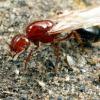Sorry in advance if this thread has already been made.
What list of things would your current self give to your younger self when you first started up this hobby? I'm going to make an ant shopping list but I don't have a clue where to begin.

Sorry in advance if this thread has already been made.
What list of things would your current self give to your younger self when you first started up this hobby? I'm going to make an ant shopping list but I don't have a clue where to begin.
The good man is the friend of all living things. - Gandhi
Test tubes, honey, Fruit flies, cotton, water
Actual glass test tubes. (15mm x 150mm) At least 25.
Featherweight forceps (to safely pick up ants and brood)
Some things I made that I am really glad I did:
Ant waterer (http://forum.formicu...der/?hl=waterer)
Grout formicarium (small 3-4 chamber ones for small colonies with 10+ workers) (http://forum.formicu...+photo +journey)
My ants did much better in a grout nest than they did in the test tubes - probably because of an outworld with a constant supply of hummingbird nectar.
If you are into IDing ants - a USB microscope. Even this cheap one worked well for me: http://www.dx.com/p/...15#.VB-MJxaGXYQ
There are others out there that are cheaper if you look.
"Always do right. This will gratify some people, and astound the rest." -- Samuel Clemens
- Glass test tubes (16 X 150 mm).
- Organic cotton (I have found this especially important for ensuring high success rates, although others may disagree with me).
- Hydrostone (for constructing formicaria and layering the bottom of foraging arenas).
- Apterous fruit fly (Drosophila melanogaster) cultures - these are an ideal staple for small colonies of most species, although you should offer a variety of other food sources as well.
- Rubber tubing (for connecting nests and foraging arenas).
- Silicone (I use the aquarium type).
This is about all you need for successful colonies, but you can opt to pay quite a bit more for better aesthetics or ease of use.
Edited by Myrmicinae, September 21 2014 - 7:08 PM.
Ah, rubber tubing. Something I would have overlooked.
Thanks for the lists.
The good man is the friend of all living things. - Gandhi
To add to those lists:
Syringes - The needle point ones. These are great for feedings without having to open the test tube.
Tupperwear containers - To put your test tube setups in when they start getting to the point where they should forage.
I forgot to add - 15 watt heat cable if your house is cooler than 22C.
"Always do right. This will gratify some people, and astound the rest." -- Samuel Clemens
An oven to put your formicariums in.
A what? ![]()
Just kidding. I've ruined a lot of my formicarium designs putting them in the oven because I'm impatient an hate waiting for things to dry.
Ohhhh now I get it.
Wait, you make grout/plaster nests?
Sometimes I use things like hydrostone or silicone, or just plain glue.
I'll throw my two cents in:
Patience and time, especially if your starting from one queen, it is important that you take it easy and slow, and make sure you do everything you can to reduce stress and other irritants.
I forgot to add - 15 watt heat cable if your house is cooler than 22C.
My house is a little warmer at around 78-80F but all the queens I've had so far have not faired well in my house. My recent dorymyrmex b. queens are in my garage where it sits around ~85F and their eggs are developing well. Heating cable seems like a good idea.
The good man is the friend of all living things. - Gandhi
Heating cable seems like a good idea.
Says someone in Arizona?! Here in nice cooler California, I do not use heating cables.
that's one of your downfalls gregory. Use your heating cables if they are available
Stop acting all smart Alza, heating cables are for people like Crystals and Mercutia, where it snows in the winter. It has been warmer in Simi Valley than it has been in Phelan for the last few days, if anything my ants are dying because of heat. Now Arizona is probably even warmer than that.
Says someone in Arizona?! Here in nice cooler California, I do not use heating cables.
If your queens are indoors, I don't think it matters much where you live, what matters is what temperature you keep your house at.
If your queens are indoors, I don't think it matters much where you live, what matters is what temperature you keep your house at.
Exactly the same as outside. ![]()
Plus, there are no negatives of not using one, it just slightly increases brood development, which I currently want going as slow as possible.
0 members, 1 guests, 0 anonymous users